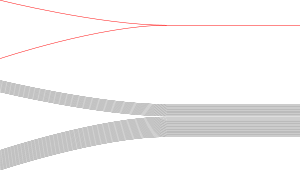
Train track
Encyclopedia

In the mathematical
Mathematics
Mathematics is the study of quantity, space, structure, and change. Mathematicians seek out patterns and formulate new conjectures. Mathematicians resolve the truth or falsity of conjectures by mathematical proofs, which are arguments sufficient to convince other mathematicians of their validity...
area of topology
Topology
Topology is a major area of mathematics concerned with properties that are preserved under continuous deformations of objects, such as deformations that involve stretching, but no tearing or gluing...
, a train track is a family of curves embedded on a surface
Surface
In mathematics, specifically in topology, a surface is a two-dimensional topological manifold. The most familiar examples are those that arise as the boundaries of solid objects in ordinary three-dimensional Euclidean space R3 — for example, the surface of a ball...
, meeting the following conditions:
- The curves meet at a finite set of vertices called switches.
- Away from the switches, the curves are smooth and do not touch each other.
- At each switch, three curves meet with the same tangent line, with two curves entering from one direction and one from the other.
The main application of train tracks in mathematics is to study laminations of surfaces, that is, partitions of closed subsets of surfaces into unions of smooth curves. Train tracks have also been used in graph drawing
Graph drawing
Graph drawing is an area of mathematics and computer science combining methods from geometric graph theory and information visualization to derive two-dimensional depictions of graphs arising from applications such as social network analysis, cartography, and bioinformatics...
.
Train tracks and laminations

A switch in a train track models a point where two families of parallel curves in the lamination merge together to become a single family, as shown in the illustration. Note that, although the switch consists of three curves ending in and intersecting at a single point, the curves in the lamination do not have endpoints and do not intersect each other.
For this application of train tracks to laminations, it is often important to constrain the shapes that can be formed by connected components of the surface between the curves of the track. For instance, Penner and Harer require that each such component, when glued to a copy of itself along its boundary to form a smooth surface with cusps, have negative cusped Euler characteristic
Euler characteristic
In mathematics, and more specifically in algebraic topology and polyhedral combinatorics, the Euler characteristic is a topological invariant, a number that describes a topological space's shape or structure regardless of the way it is bent...
.
A train track with weights, or weighted train track or measured train track, consists of a train track with a non-negative real number
Real number
In mathematics, a real number is a value that represents a quantity along a continuum, such as -5 , 4/3 , 8.6 , √2 and π...
, called a weight, assigned to each branch. The weights can be used to model which of the curves in a parallel family of curves from a lamination are split to which sides of the switch. Weights must satisfy the following switch condition: The weight assigned to the ingoing branch at a switch should equal the sum of the weights assigned to the branches outgoing from that switch.
Weights are closely related to the notion of carrying. A train track is said to carry a lamination if there is a train track neighborhood such that every leaf of the lamination is contained in the neighborhood and intersects each vertical fiber transversely. If each vertical fiber has nontrivial intersection with some leaf, then the lamination is fully carried by the train track.

